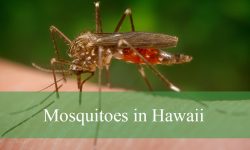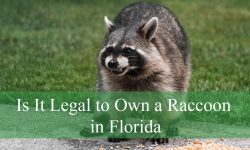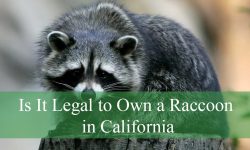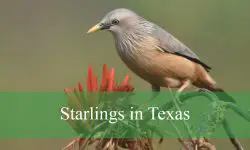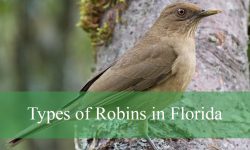Florida’s diverse landscapes and mild climate make it a haven for birdwatchers, especially those seeking to spot some of the most beautiful blue birds in Florida. From lush wetlands to coastal mangroves and suburban backyards, these vibrant birds add a splash of color to every environment. If you’re a birding enthusiast or simply enjoy nature, exploring the various species of blue birds in Florida is a truly rewarding experience.
This guide highlights 20 types of blue birds in Florida, offering insight into their unique features, habitats, and behaviors. Some species, like the Eastern Bluebird, are year-round residents, while others, such as the Cerulean Warbler or Blue-winged Teal, are migratory visitors. With helpful identification tips and vivid descriptions, you’ll be able to recognize each species with confidence.
Understanding the different types of blue birds in Florida can deepen your appreciation for the state’s rich birdlife. From the brilliant indigo of a bunting to the shimmering blue of a grackle’s feathers, these birds offer stunning sights for all who take the time to look. Whether observing from a nature trail or your backyard feeder, there’s always a chance to spot one of Florida’s dazzling blue-feathered residents.
Common Blue Birds in Florida (Year-round Residents)
Eastern Bluebird (Sialia sialis)
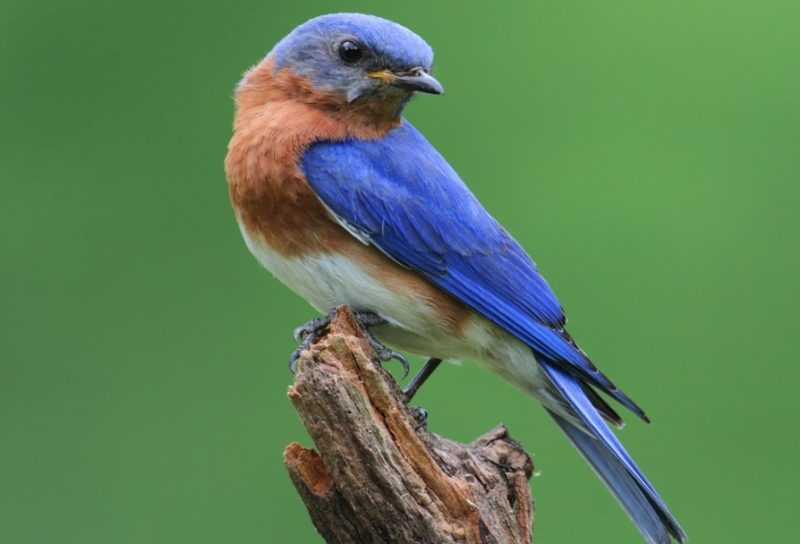
The Eastern Bluebird is a small, striking songbird known for its vibrant plumage and cheerful calls. Males have a bright blue head, back, and wings contrasted by a warm reddish-orange chest and white belly. Females are duller in color but still show hints of blue and rust tones. Measuring around 6.5 to 8.5 inches in length, with a wingspan of 9.8 to 12.6 inches, they are petite and agile in flight.
In Florida, Eastern Bluebirds are common throughout the state, especially in open habitats like pastures, fields, orchards, and golf courses, where they perch on low branches or fence posts to scout for food. They prefer areas with scattered trees and minimal underbrush, often nesting in natural cavities or birdhouses. Their breeding season begins in early spring, and they are known for producing multiple broods each year.
Their diet consists mainly of insects and other invertebrates during the warmer months, including beetles, caterpillars, grasshoppers, and spiders. In winter, they rely more heavily on berries and fruits such as dogwood, holly, and sumac. Eastern Bluebirds play an important role in controlling insect populations and are a favorite among birdwatchers due to their beauty and gentle nature.
Blue Jay (Cyanocitta cristata)

The Blue Jay is a highly recognizable bird with brilliant blue upperparts, a white chest, and a distinct black necklace-like marking across the throat. Its crest, loud calls, and intelligence make it a standout among backyard birds. Blue Jays are medium-sized, ranging from 9 to 12 inches in length with a wingspan of 13 to 17 inches, and they often appear larger due to their full crest and bold personality.
Common across Florida year-round, Blue Jays inhabit a variety of environments including forests, suburban neighborhoods, parks, and woodlands. They are especially drawn to oak trees due to their fondness for acorns. Blue Jays are known for their complex social behavior, mimicking other birds’ calls (even hawks), and forming tight family units. They are also frequent visitors to feeders.
Their diet is omnivorous, including insects, nuts, seeds, fruits, and small vertebrates or eggs. They are particularly famous for caching food, especially acorns, which they bury to eat later. This behavior inadvertently helps in tree dispersal, especially oak forests. While sometimes aggressive, Blue Jays are also highly intelligent and play a valuable role in Florida’s bird ecosystems.
Blue-gray Gnatcatcher (Polioptila caerulea)
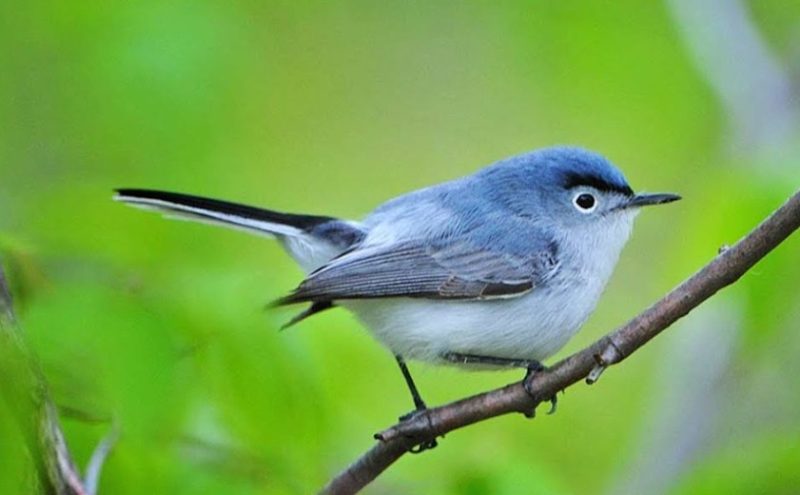
The Blue-gray Gnatcatcher is a tiny, slender bird with soft blue-gray upperparts, a white underside, and a long black-and-white tail. It has a fine bill and is often seen flitting about energetically with quick, jerky movements. With a body length of just 3.9 to 4.3 inches and a wingspan of around 6 inches, this bird is one of the smallest songbirds found in Florida.
It is a widespread species throughout the state, favoring deciduous forests, hammocks, coastal scrub, and wooded wetlands. In Florida, they are year-round residents in southern parts and winter visitors in northern areas. Blue-gray Gnatcatchers are highly active and often hard to spot due to their speed and size, but their nasal “spee-spee” calls give them away as they forage through treetops.
These birds primarily feed on small insects and spiders, gleaning them from leaves and branches or catching them midair. Their constant tail-flicking may help flush insects from foliage. During migration and breeding seasons, they can become territorial and will aggressively defend their nests. Despite their small size, their feisty behavior and agility make them fascinating to observe.
Florida Scrub-Jay (Aphelocoma coerulescens)

The Florida Scrub-Jay is a unique species found only in Florida, making it the state’s only truly endemic bird. It has a bright blue head, wings, and tail with a pale gray back and underparts, and it lacks the crest seen in Blue Jays. These birds measure about 9.1 to 11 inches long with a wingspan of 13 to 14 inches. Their distinct color and limited range make them a species of great conservation concern.
They inhabit oak scrub habitats, primarily in central and southeastern Florida, including regions like Ocala National Forest and the Lake Wales Ridge. These environments are characterized by sandy soil, low-growing oaks, and open spaces—conditions maintained by periodic fires. Florida Scrub-Jays are highly social and live in family groups, often helping raise siblings and defend territories together.
Their diet includes a mix of insects, small vertebrates, fruits, and especially acorns, which they bury in the sand for later consumption. These birds are intelligent and known for their strong memory, allowing them to recover cached food. Due to habitat loss and fragmentation, their populations are declining, and they are listed as a threatened species. Conservation efforts focus on habitat preservation and restoration to support their survival.
Migratory or Seasonal Blue Birds
Indigo Bunting (Passerina cyanea)
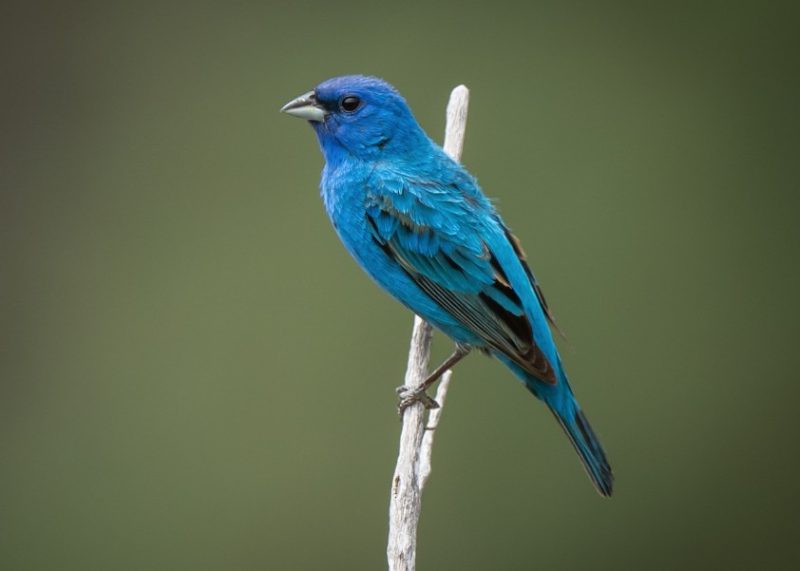
The Indigo Bunting is a small, eye-catching songbird with males displaying brilliant blue plumage that can appear almost glowing in sunlight. Females and juveniles, in contrast, are brown with faint streaks, allowing them to blend more easily into their surroundings. These birds are around 4.5 to 5 inches long with a wingspan of about 7.5 to 9 inches, and they have short, conical bills well-suited for seed eating.
In Florida, Indigo Buntings are mainly seen during migration in spring and fall, though some breed in the northern parts of the state. They prefer open habitats such as woodland edges, brushy fields, and hedgerows. During migration, they may also visit gardens and parks, especially if food sources are available. Their sweet, high-pitched songs often give away their presence in dense vegetation.
Their diet primarily consists of seeds, berries, and small insects. During the breeding season, they rely more on insects like caterpillars, beetles, and spiders to feed their young. Indigo Buntings often forage low in vegetation or on the ground and may occasionally visit feeders. Their migration is nocturnal and guided by the stars, making their annual journeys especially fascinating to researchers and bird lovers alike.
Blue Grosbeak (Passerina caerulea)
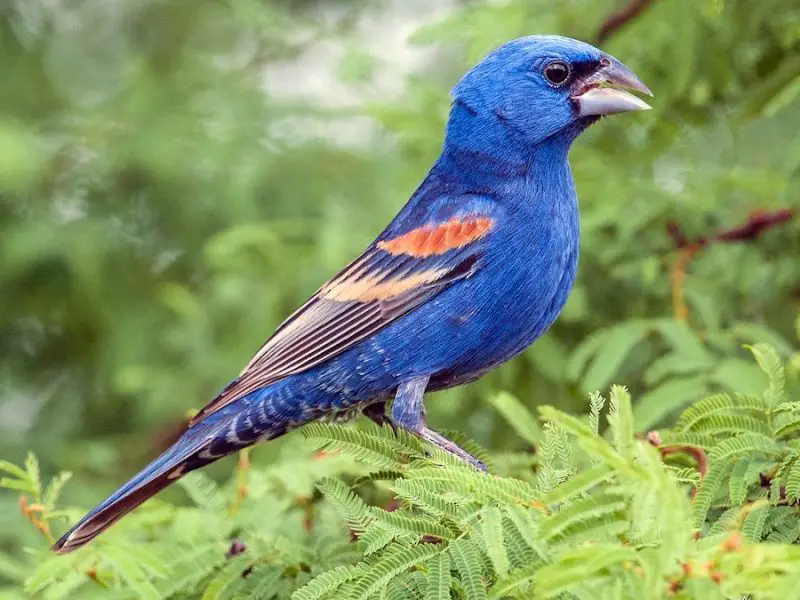
The Blue Grosbeak is a medium-sized songbird with a stout build and a striking appearance. Adult males are deep, rich blue all over with chestnut wing bars, while females are mostly warm brown with hints of blue and pale wing bars. Measuring about 5.5 to 7.5 inches in length with a wingspan of 10 to 11 inches, they possess a powerful silver beak adapted for cracking seeds.
In Florida, Blue Grosbeaks are primarily seen as summer breeders in the northern and central regions, while they pass through southern Florida during migration. Their preferred habitats include shrubby fields, woodland edges, and overgrown pastures. They are more secretive than other buntings, often staying hidden within thick foliage, but their melodious, warbling songs can help identify them.
Their diet includes a wide range of insects such as grasshoppers and caterpillars, along with seeds and grains. During breeding season, insects become the main food source for both adults and nestlings. They forage both in vegetation and on the ground and occasionally visit feeders offering millet or sunflower seeds. Despite being relatively shy, their rich coloration and song make them a rewarding species for patient birdwatchers.
Painted Bunting (Passerina ciris)
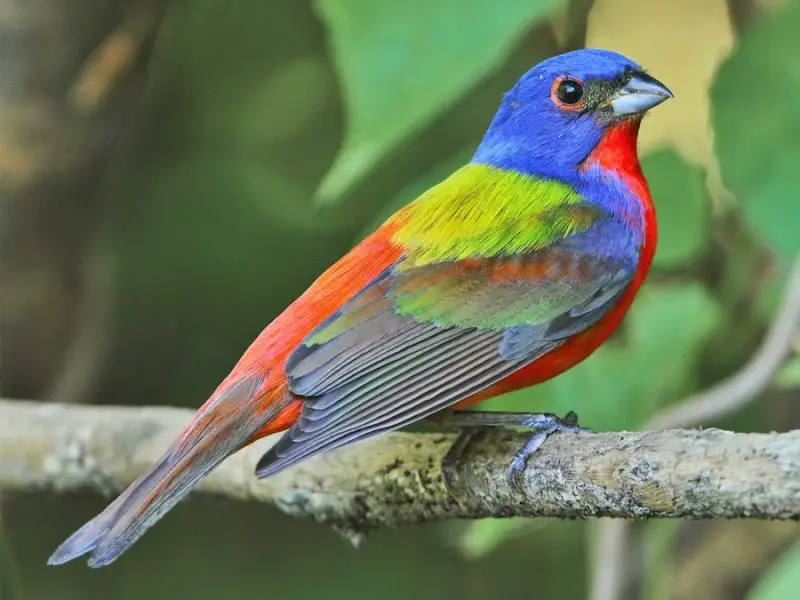
The Painted Bunting is often described as one of the most colorful birds in North America. Males boast a stunning mix of blue heads, green backs, and red underparts, while females and immatures are a vibrant lime green overall. These birds are small, about 4.7 to 5.5 inches long, with a wingspan of approximately 8.5 inches, and they have strong, seed-crushing beaks.
In Florida, Painted Buntings are mainly found in the central and southeastern parts of the state during winter, though some breed in northern Florida along the coast. They favor habitats like coastal thickets, weedy fields, woodland edges, and backyard feeders with dense cover. Males are more visible during breeding when they sing from exposed perches, while females tend to stay low and hidden.
Their diet consists of seeds, especially grass and weed seeds, as well as small fruits and insects. During the breeding season, they rely more on insects to provide protein for their young. These buntings are frequent visitors to feeders, especially those offering white millet. Conservation efforts in Florida focus on maintaining and protecting their shrinking habitat, particularly during migration and wintering months.
Cerulean Warbler (Setophaga cerulea)
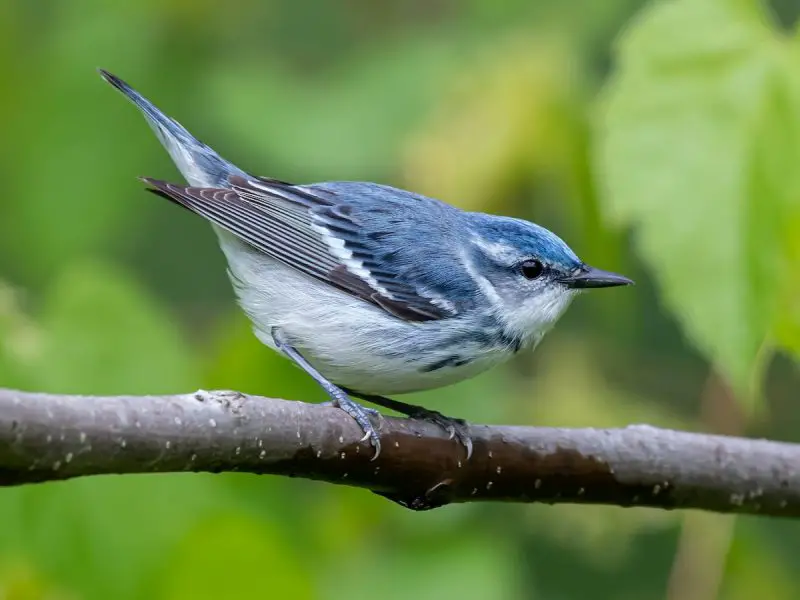
The Cerulean Warbler is a small and delicate bird with males featuring a sky-blue back, white underparts, and a narrow dark blue band across the chest. Females are a more subdued blue-green above with yellowish tones below. They measure about 4.3 inches long with a wingspan of 7.9 inches and are among the fastest-declining warblers in North America due to habitat loss.
In Florida, Cerulean Warblers are primarily seen during spring and fall migration, as they pass through the state on their way to and from breeding grounds in the Appalachian Mountains and wintering areas in South America. They prefer tall deciduous forests during migration, especially those near water or with high tree canopies. Spotting them can be challenging, as they often forage high in the treetops.
Their diet consists almost entirely of insects and other small arthropods. They glean caterpillars, beetles, and flies from leaves and twigs while flitting through the canopy. Due to their elusive behavior and declining numbers, sightings in Florida are often brief but cherished by experienced birders. Conservation efforts across their migratory range are crucial to ensure the survival of this beautiful but vulnerable species.
Northern Parula (Setophaga americana)

The Northern Parula is a small, vibrantly colored warbler featuring bluish-gray upperparts with a greenish back patch, a yellow throat and chest, and two bold white wing bars. Males often display a dark chest band that helps distinguish them from females. They are compact, about 4.3 inches long, with a wingspan of 6.3 to 7.1 inches, and have a slightly downcurved bill ideal for picking insects from foliage.
In Florida, Northern Parulas are widespread and among the earliest migrant warblers to return each spring. They breed across much of the state, especially in moist forests, cypress swamps, and hammock woodlands where epiphytic plants like Spanish moss or lichens are abundant. These materials serve as nesting sites, as the birds often suspend their nests within hanging moss.
Their diet consists primarily of insects and spiders, which they glean from leaves and branches in the canopy. They’re known for their buzzy, rising trill of a song, which makes them easier to detect than to see, as they often remain high in the treetops. Agile and restless, the Northern Parula adds vivid color and energy to Florida’s spring and summer woodlands.
Blue-headed Vireo (Vireo solitarius)
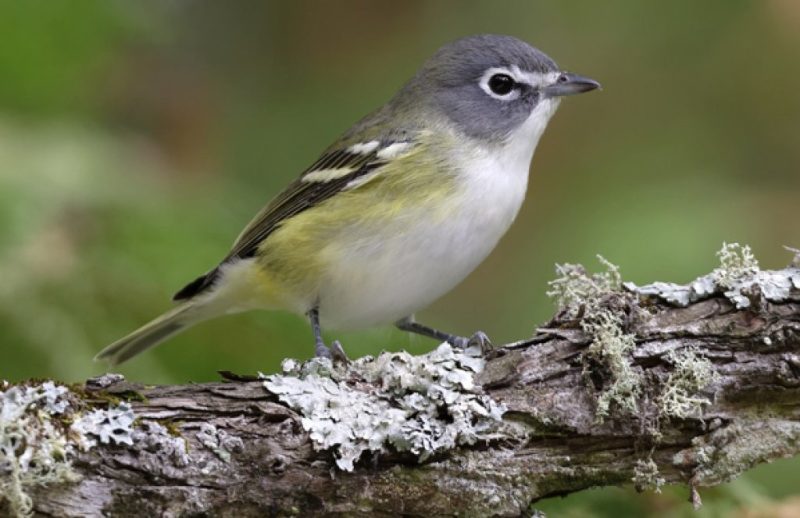
The Blue-headed Vireo is a small, stocky songbird with a slate-blue head, bold white spectacles around the eyes, olive-green back, and white underparts with yellowish flanks. It has a short, thick bill and strong legs suited for foraging in the forest understory. These birds measure around 5 to 5.5 inches long with a wingspan of 8 to 9 inches.
In Florida, the Blue-headed Vireo is primarily a winter resident, most often found in woodlands, pine forests, and hammock habitats from fall through early spring. They are methodical foragers, moving slowly among branches and pausing often to inspect leaves for prey. Their deliberate pace and distinctive “cheerful” song help birders locate them even in dense foliage.
Their diet is mainly insectivorous, feeding on caterpillars, beetles, and other arthropods, but they also consume small fruits and berries in the cooler months. They typically forage in the mid-canopy, often hanging upside down to reach prey. Calm and inquisitive, Blue-headed Vireos are reliable presences in Florida’s winter woods and are among the most approachable vireos.
Purple Martin (Progne subis)
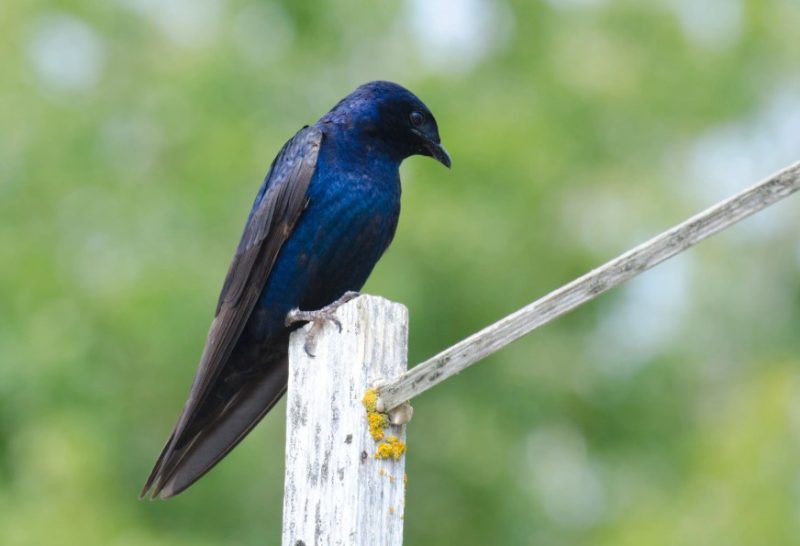
The Purple Martin is the largest swallow in North America, with males displaying glossy, dark blue-purple plumage and slightly forked tails. Females and juveniles are duller with grayish bellies and less iridescence. These birds are around 7.5 to 8 inches long with a wingspan of up to 12 inches and are known for their graceful, acrobatic flight.
In Florida, Purple Martins are early spring arrivals and breed throughout much of the state. They are especially associated with human-provided housing, such as martin houses or gourd colonies, as they depend almost entirely on artificial nesting sites in the eastern U.S. They prefer open areas near water and are highly social, often forming large breeding colonies.
Their diet consists entirely of flying insects, including dragonflies, beetles, wasps, and moths, which they catch in midair with incredible precision. They are daytime feeders and rarely come to ground. With their melodic gurgling calls and communal roosting habits, Purple Martins are a beloved summer fixture in Florida neighborhoods, especially where nest boxes are maintained annually.
Tree Swallow (Tachycineta bicolor)
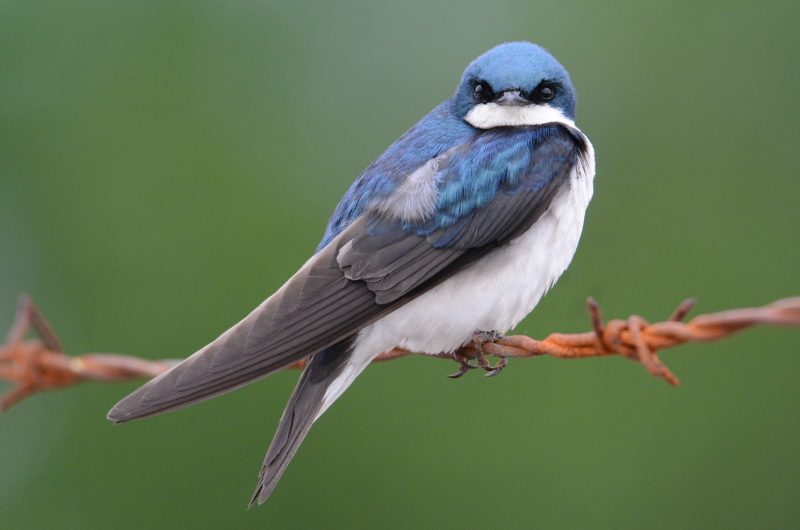
The Tree Swallow is a sleek, medium-sized swallow with iridescent blue-green upperparts and clean white underparts. Juveniles and females may appear duller with some brownish tones. With a streamlined body, short bill, and pointed wings, these birds are built for speed and agility. They typically measure about 5.1 to 5.9 inches in length with a wingspan of 11.8 to 13 inches.
In Florida, Tree Swallows are seen mostly during migration and in winter, though small numbers may breed in northern parts of the state. They favor open wetlands, agricultural fields, and coastal marshes where they can feed over water or open ground. During migration, they often gather in large flocks, sometimes numbering in the thousands, creating impressive aerial displays.
Their diet is almost exclusively composed of flying insects such as flies, midges, and mosquitoes, but they will also eat plant material, particularly berries, during colder months. Tree Swallows often nest in cavities or nest boxes and are quick to take advantage of suitable locations near water. Their glossy plumage and aerial prowess make them a striking sight in Florida’s skies.
Wetland and Wading Birds with Blue Features
Great Blue Heron (Ardea herodias)
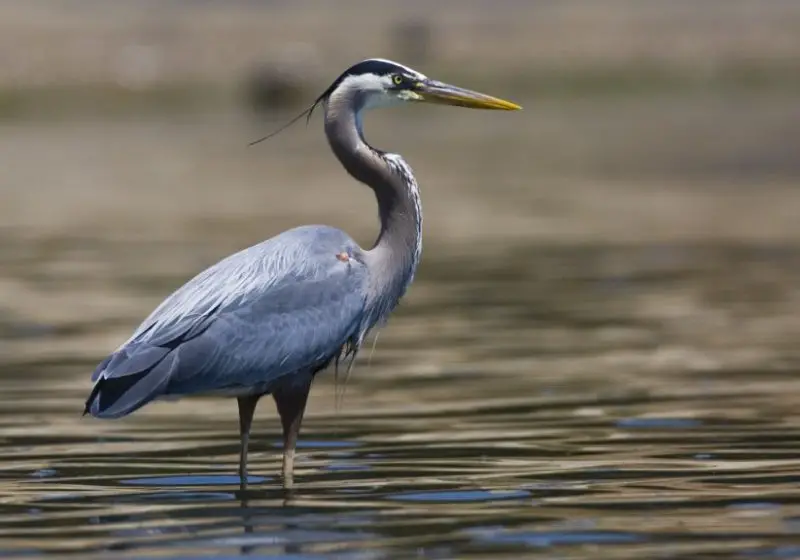
The Great Blue Heron is the largest heron in North America, standing about 4 feet tall with a wingspan reaching up to 6.5 feet. It has a long neck, dagger-like bill, and mostly blue-gray plumage with black plumes on the head. In flight, it tucks its neck into an “S” shape, distinguishing it from similar large birds like cranes or storks.
This majestic wader is found year-round throughout Florida, inhabiting freshwater and saltwater environments alike. It frequents marshes, swamps, rivers, lakes, mangroves, and even urban retention ponds. Great Blue Herons are solitary feeders and often stand motionless while hunting, patiently waiting to strike at fish, frogs, crustaceans, and occasionally small mammals or reptiles.
They feed by wading slowly or standing still, using their long bills to spear prey with lightning-fast precision. These herons nest in tall trees, often in colonies known as rookeries. Despite their large size and deliberate movements, they are remarkably graceful in flight and are a familiar and iconic sight across Florida’s wetlands.
Little Blue Heron (Egretta caerulea)
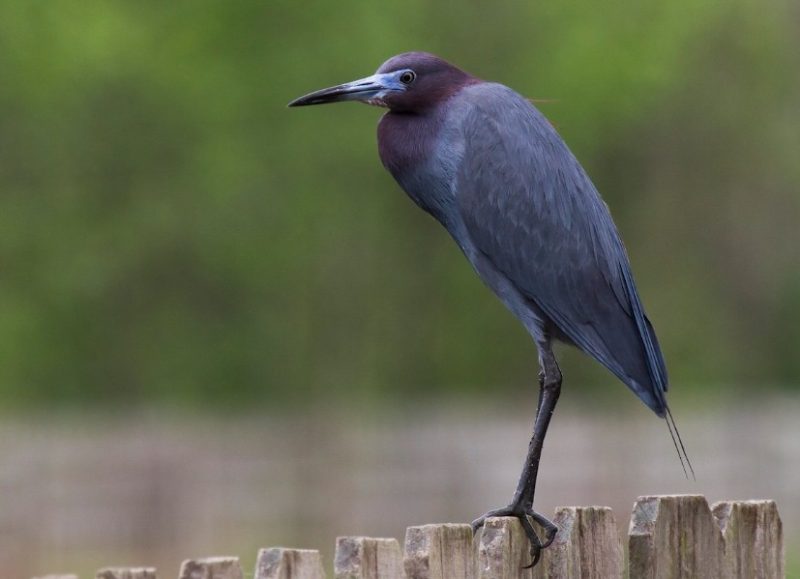
The Little Blue Heron is a medium-sized wading bird with adults showcasing elegant slate-blue plumage and a maroon-colored neck in breeding season. Juveniles, in contrast, are entirely white during their first year, gradually molting into blue as they mature. Adults reach about 2 feet in height with a wingspan around 40 inches.
This species is widespread in Florida year-round and is commonly found in shallow wetlands, marshes, ponds, ditches, and mangroves. Unlike some more social herons, the Little Blue Heron is often seen foraging alone or in loose groups. It is quieter and more reserved, typically stalking prey with slow, deliberate movements.
Their diet is diverse, consisting mainly of small fish, amphibians, insects, and crustaceans. Juveniles’ white plumage may offer a hunting advantage, allowing them to mix with flocks of Snowy Egrets and gain access to more prey. These herons are important indicators of healthy wetland ecosystems and are frequently seen around Florida’s coastal and inland water bodies.
Belted Kingfisher (Megaceryle alcyon)
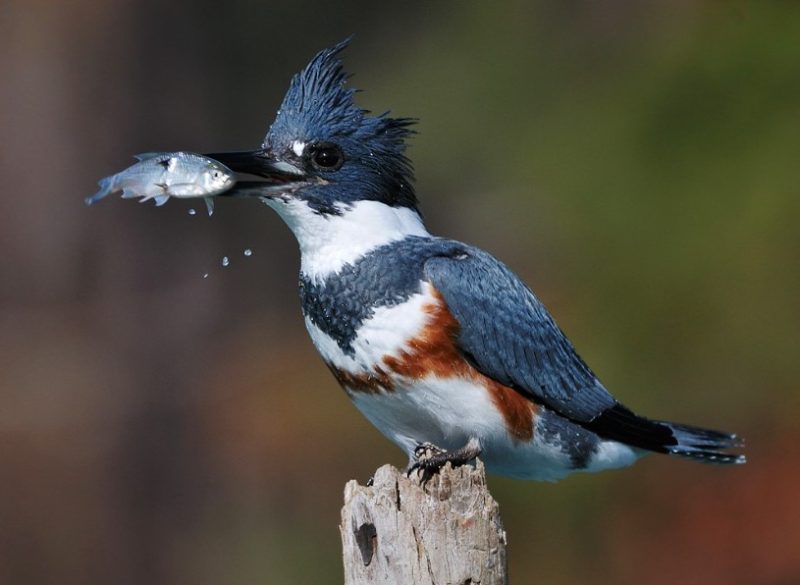
The Belted Kingfisher is a stocky, crested bird with a shaggy blue-gray head, white collar, and a distinctive blue band across its chest—females also have a rufous band below the blue one, making them one of the few bird species where the female is more colorful than the male. They measure about 11 to 14 inches in length with a wingspan of 19 to 23 inches.
In Florida, Belted Kingfishers are primarily winter visitors, although some remain year-round, especially in the northern regions. They inhabit rivers, lakes, estuaries, and coastlines, where they perch conspicuously near water to hunt. Their loud rattling calls often reveal their presence before they’re seen flying quickly over the water with rapid wingbeats.
These birds are expert fishers, diving headfirst into the water from a perch to capture small fish and aquatic invertebrates. They also eat amphibians and insects. Belted Kingfishers nest in burrows they excavate in sandy banks along rivers or lakes. Their keen eyesight and precise diving behavior make them fascinating to watch along Florida’s waterways.
Blue-winged Teal (Spatula discors)

The Blue-winged Teal is a small, migratory duck recognized by its powder-blue wing patches, which are most visible in flight. Males in breeding plumage feature a bold white facial crescent and dark bodies, while females are mottled brown with subtle blue and green in the wings. They measure about 14 to 16 inches long with a wingspan of 22 to 24 inches.
In Florida, Blue-winged Teals are common winter residents, arriving in large numbers during fall migration and staying through early spring. They favor shallow wetlands, marshes, flooded fields, and coastal lagoons. While not typically seen during the breeding season in Florida, some may linger later in the north or pass through during spring migration.
These dabbling ducks feed primarily on seeds and aquatic vegetation but also consume insects, snails, and other small invertebrates, especially during migration and breeding. They forage in shallow water by tipping forward rather than diving. Blue-winged Teals are among the earliest migrants in both fall and spring, and their graceful movements and striking plumage make them a seasonal favorite for Florida birders.
Iridescent or Partially Blue Birds
Boat-tailed Grackle (Quiscalus major)
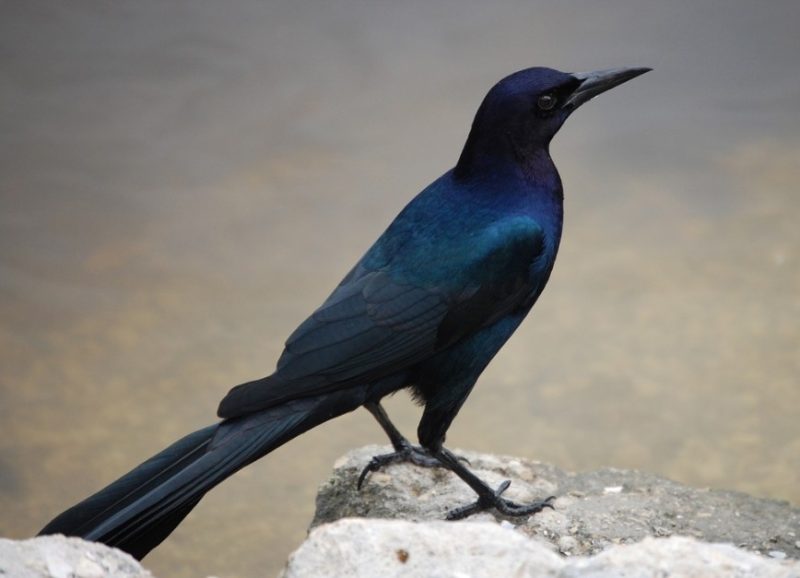
The Boat-tailed Grackle is a large, glossy blackbird with striking iridescent blue and purple tones on the head and body, especially prominent in males. Males also have long, keel-shaped tails that resemble a boat’s hull when spread, which is the origin of the bird’s name. Females are significantly smaller and browner, with much shorter tails and a more subtle appearance.
This species is commonly found year-round throughout Florida, especially along the coast and in wetlands, marshes, mangroves, and even urban parks. Boat-tailed Grackles are highly adaptable and are often seen strutting boldly on boardwalks, docks, and parking lots. They are extremely vocal birds, known for their loud, harsh calls, creaks, and whistles.
Boat-tailed Grackles have an omnivorous diet that includes insects, small fish, crustaceans, seeds, and human food scraps. They forage on the ground, in shallow water, or steal from other birds. Their ability to thrive in both natural and human-altered environments makes them one of the most recognizable and widespread birds in coastal and central Florida.
Common Grackle (Quiscalus quiscula)

The Common Grackle is slightly smaller than its boat-tailed relative but similarly iridescent, with glossy blue, green, and bronze plumage depending on light. It has a long, wedge-shaped tail, a stout bill, and pale yellow eyes that give it an intense stare. Males are larger and glossier than females, which are more subdued in color.
In Florida, the Common Grackle is a year-round resident and is found across the state in a variety of habitats, including woodlands, suburban areas, agricultural fields, and wetlands. Unlike the Boat-tailed Grackle, it is more commonly seen inland and can be found in large flocks outside of the breeding season. It nests in conifer trees, shrubs, or even human structures when available.
These birds are opportunistic feeders, consuming everything from insects, grains, and fruits to garbage and small vertebrates. They often forage in flocks, sometimes mixed with other blackbird species, and use their strong bills to open acorns or dig for invertebrates. Their metallic-sounding songs and social behaviors make them both interesting and conspicuous members of Florida’s avian community.
Rare or Occasional Blue-Tinged Visitors
Common Gallinule (Gallinula galeata)

The Common Gallinule, also known as the Moorhen, is a medium-sized marsh bird recognized by its distinctive red facial shield, yellow-tipped red bill, and long greenish legs. Its plumage is mostly dark charcoal-gray to black, but under the right lighting, the head and back show a subtle iridescent sheen of blue and purple, giving the bird a surprisingly colorful appearance.
This species is a year-round resident throughout Florida, thriving in freshwater wetlands such as ponds, lakes, canals, and marshes with abundant aquatic vegetation. It often walks on floating plants or wades through shallow water with its long toes. Common Gallinules are quite vocal, emitting loud clucks and squawks, especially during the breeding season.
Their diet consists mainly of plant material—seeds, leaves, and algae—but they also consume insects, snails, and small aquatic animals. These birds are skillful swimmers despite lacking webbed feet and will also climb among reeds and vegetation. They build floating nests and are highly protective parents, often seen escorting their black, downy chicks through the water.
Shiny Cowbird (Molothrus bonariensis)

The Shiny Cowbird is a small, sleek blackbird with a striking metallic blue or violet sheen, most vivid in males. Females are a plain brown color and lack the iridescence. The species is slightly smaller than the Common Grackle, measuring about 7 to 8 inches in length, and is best identified by its glossy, bluish appearance and relatively short tail.
Although native to South America, the Shiny Cowbird has expanded its range northward and is now occasionally observed in South Florida, particularly in open habitats like pastures, urban parks, and agricultural areas. It is not common in the state but may appear sporadically, especially near the southern tip and in the Florida Keys.
Like other cowbirds, the Shiny Cowbird is a brood parasite—it lays its eggs in the nests of other bird species, leaving them to raise its young. This can have negative effects on host populations, particularly native songbirds. The species forages on the ground for seeds and insects and often joins mixed flocks of grackles and other blackbirds when present in Florida.

